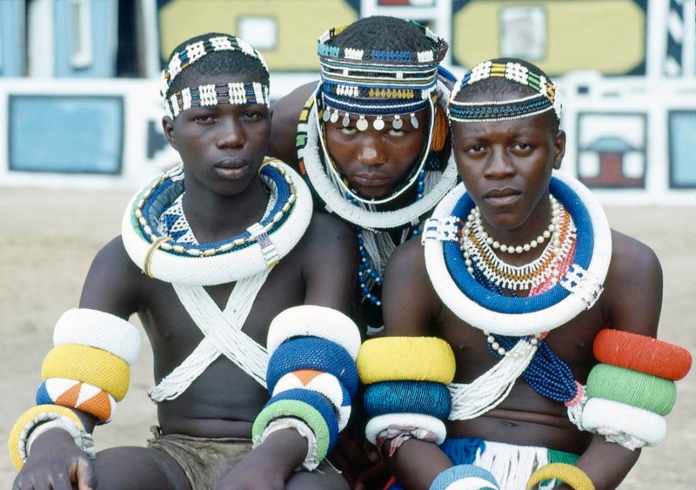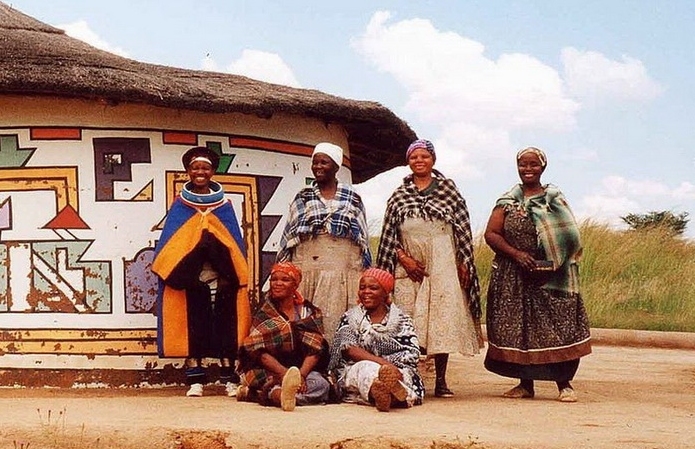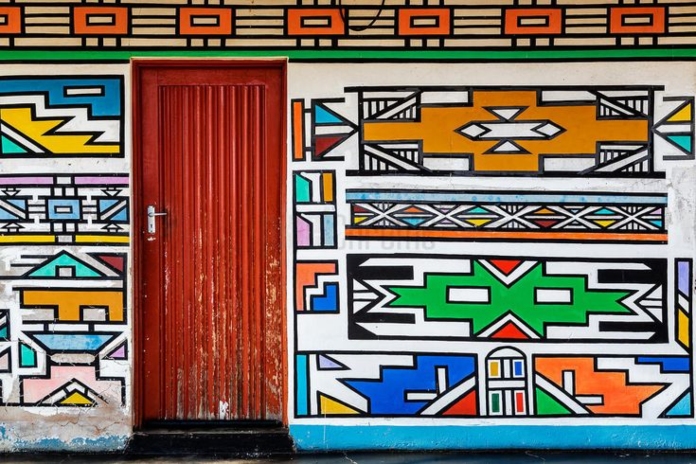Ndebele People of South Africa are one of the four Bantu ethnic groups, and as a result of the dispute they had with Zulu people in ancient times, they moved away from them, and some of the Ndebele people fled to Zimbabwe. However, those who remained in South Africa are renowned today for their rich cultural art heritage. In ancient times, to uphold the fundamentals of their tradition, they started wall paintings.
Despite having no artistry equipment or formal education, they were able to paint their walls using geometric lines. What started as a traditional practice of a small group in South Africa has now been recognized by the world and can be found in museums. Aside from their walls, their unique geometric shapes and designs can also be found in Ndebele beadworks and fabrics. To learn more facts about the Ndebele art pattern, keep reading.
Brief History Of Ndebele Art Patterns
Ndebele People used to be part of the Hlubi people from KwaZulu-Natal but broke away in the 1600s and moved to the interior part of South Africa to live near the Pedi people. Around this time, the Nzunza and Manala Ndebele clans were introduced to wall painting. Wall painting in Ndebele became a tradition around 1883 when the Nzunza Ndebele clan was defeated by President Paul Kruger’s Zuid-Afrikaansche Republiek’s army and were forced out of their ancestral land to work in Boer farms. To maintain their cultural identity, they started painting their walls.
To the surprise of most commentators, the apartheid government did not stop the people of Ndebele from drawing geometric designs of murals on their walls; rather, they encouraged it and were kind enough to create cultural villages to serve as advertisements for tribal purity. Counting the number of decades the Ndebele people had fought to maintain and uphold their cultural heritage of art, one would have thought that it would have been impossible for them to stop painting houses, but what even the apartheid government was unable to do, the country’s economy has done it.
Today, most Ndebele people no longer paint their houses and have moved to big cities searching for greener pastures. However, this cultural heritage is too beautiful to be swept under the floor. You can still see it on their beadworks and clothing items.
Facts About The Ndebele Art Patterns
1. Ndebele Painting Has Detailed Geometric Pattern, Colorful Architecture And Are Not Figurative
One fact about Ndebele Art Patterns is that it is colorful and made up of bright colors like yellow, blue, red, and white. These colors are used to bring out the geometry of the design, the designs, and patterns on Ndebele arts and do not represent any object or animal; as such, they are not figurative.
2. Ndebele People Paint their Houses With Unique Colours And Patterns
In ancient times, the Ndebele people beautified their houses with patterns and colors. The colors and patterns on the house could be used to know a woman’s place in society, whether she is married and if she has children. The art and style of Ndebele people are known as abstract art.
3. Men Take Care Of The Architecture And Construction

Ndebele houses are usually rectangular in shape, and the construction and architecture on which the painting is made are designed and constructed by the Ndebele men. The houses are made with dry mud, clay mixture of dunk and tree trunk.
4. Women Are In Charge Of Painting
Ndebele women were responsible for painting their houses, and they majorly used chicken feathers to paint (civilization has replaced the chicken feathers with brushes). The murals express the identity and cultural rites of the Ndebele people. One of such cultural rites is during the circumcision of boys.

As the boys leave the house for the ritual, usually three months, their mothers paint the walls with the motif of the ‘razor blade.’ Also, young girls are also ‘initiated’ into the culture of Ndebele arts by their mothers. This way, the knowledge of how to make Ndebele art patterns and artwork is passed on from mother to daughter.
5. The Women Used Everything Around Them As A Source Of Inspiration
When designing and painting the walls of the house, women are inspired by anything around them, like razor blades, telephone poles, cars, and plates. As beautiful and detailed as the design patterns are, they are made with freehand and no rulers. To create the rhythmic patterns in the design, the women would run their hands around the wet clay.
6. Their Art Can Be Seen In Their Beadwork
Aside from Ndebele houses, their unique artwork and patterns can also be seen in their beadwork. And just like painting houses, women are also responsible for making beaded necklaces with anklets and bracelets. The type of bead a lady wears represents her place in society.
7. Their Art Can Be Seen In Their Clothing
Ndebele art design, patterns, and colors can also be seen in their clothing pattern. Married women wear a five-fingered apron called Ijogolo. They also wear a wedding blanket called Nguba. Modern Ndebele prints also come with these patterns.
8. In The 1940s, New Colors Were Added To Ndebele Design
Ndebele art is known to be associated with colors like blue, yellow, white, and red. However, some of these colors were added to their palette in the 1940s. To get an ultramarine color, they used Reckitt’s Blue laundry detergent.
As years continued to pass, oxides became available, and red, yellow, and green were added to their design colors. However, the murals had to be redone yearly because rain usually washes away the pigment. By the 1970s, latex paints became available, and the labor of having to redo the pigment from time to time was done away with.
9. Ndebele Art Was Brought To The Attention Of The World In The 1940s
With the help of photographers like Constance Stuart Larrabee, who took an interest in the Ndebele cultural art and design, the world began to learn about Ndebele arts and designs.
10. Esther Mahlangu Is Doing Everything She Can To Uphold The Ndebele Art
In a bid to search for greener pastures, most Ndebele people leave their villages, and the women no longer have the time for painting their houses. As a result, the Ndebele art, design, and culture are now diluted. To salvage this situation, a South African artist called Esther Mahlangu is doing all she can to uphold this cultural heritage. She has exhibited her artwork around the world.
She attended the Magiciens de la Terre exhibition at the Pompidou Center Paris, and while in Paris, in the presence of museumgoers, she recreated the design of her home in South Africa. To achieve this, she went to Paris with her chicken feather because she does not paint with brushes. She has become Internationally renowned for her work and has been contracted to decorate for brands like BMW, Belvedere, Vodka, and her work can be seen in the Virginia Museum of Fine Arts.
